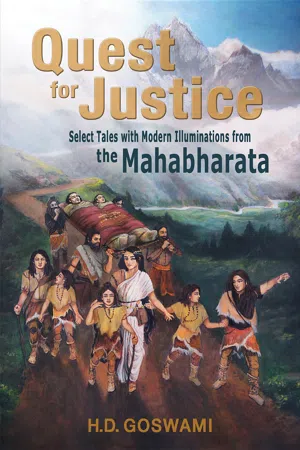![]()
Notes
1 The ancient Sanskrit word is sūta.
2 Kṛṣṇa is the speaker of Bhagavad-gītā; His name literally means “the all-attractive person.” In the Mahā-Bhārata, Śrīmad-Bhāgavatam and other Sanskrit works, Kṛṣṇa is understood to be the chief and most intimate name for the supreme monotheistic Godhead, the original cause of all causes. The Śrīmad-Bhāgavatam, for example, states, kṛṣṇas tu bhagavān svayam: “Kṛṣṇa is the original Personality of Godhead” A.C. Bhaktivedanta Swami Prabhupada, canto 1, ch. 3, v. 28 of Śrīmad-Bhāgavatam (Los Angeles: Bhaktivedanta Book Trust, 1972), 175. The ancient Brahmā-Saṃitā also proclaims, īśvaraḥ paramaḥ kṛṣṇa, sac-cid-ānanda-vigrahaḥ, “The supreme controller of everything, who possesses an eternal form, is Kṛṣṇa” Bhaktisiddhānta Sarasvatī Goswami, Brahmā-Saṃitā, Calcutta: Sri Gaudiya Math, 1932, ch.5, v.1.
3 Bhāgavata Purāṇa is another name for Śrīmad-Bhāgavatam.
4 J.A.B. van Buitenen, vol. 1, book 1 of The Mahābhārata: The Book of the Beginning. (London: The University of Chicago Press, Ltd., 1973), xxvi.
5 V.S. Sukthankar, vol. 1 of Critical Studies in the Mahābhārata (Bombay: Karnatak Publishing House, 1944), 12-13.
6 Gāndhārī, one of the Mahā-bhārata’s primary figures, is the wife of the blind king Dhṛtarāṣṭra and the mother of one hundred sons. Gāndhārī is regarded as the emblem of virtue and wifely devotion; she is among the most esteemed moral forces of the Great Epic. Having married a blind person, she resolved at the time of her wedding to also spend the rest of her life blind, so as to share in her husband’s fate. Thus she tied a cloth around her eyes, depriving herself of the power to see. Gāndhārī never wavered in her adherence to dharma, and, at certain critical points in the narrative, gave impeccable moral advice to her husband.
7 See Monier Williams Sanskrit-English Dictionary (2008 revision), definition of dharma, http://www.sanskrit-lexicon.uni-koeln.de/monier/
8 Ibid.
9 The Śrīmad-Bhāgavatam addresses this in the eleventh canto: kṛṣṇa-varṇaṁ tviṣākṛṣṇaṁ sāṅgopāṅgāstra-pārṣadam; yajñaiḥ saṅkīrtana-prāyair yajanti hi su-medhasaḥ: “In the Age of Kali, intelligent persons perform congregational chanting to worship the incarnation of Godhead who constantly sings the names of Kṛṣṇa. Although His complexion is not blackish, He is Kṛṣṇa Himself. He is accompanied by His associates, servants, weapons and confidential companions.” The Disciples of A.C. Bhaktivedanta Swami Prabhupada, canto 11, ch. 5, v. 32 of Śrīmad-Bhāgavatam (Los Angeles: Bhaktivedanta Book Trust, 1987), 489.
10 H.D. Goswami, ch. 1, v. 1 of A Comprehensive Guide to Bhagavad-Gītā with Literal Translation (Gainesville: Krishna West, Inc., 2015), 151.
11 Ibid., ch. 2, v. 32, 157.
12 Ibid., ch. 2, v. 7, 155.
13 Ibid., ch. 4, v. 7, 165.
14 Ibid., ch. 4, v. 8, 165.
15 Ibid., ch. 9, vv. 21-22, 182.
16 Ibid., ch. 18, v. 13, 208.
17 Ibid., ch. 14, v. 27, 199.
18 Ibid., ch. 9, v. 66, 182.
19 Online Bhaktivedanta VedaBase, Śrīmad-Bhāgavatam, canto 1, ch. 2, vv. 28-29; http://www.vedabase.com/en/sb.
19b See canto 8, ch. 10, vv. 1-57 of Śrīmad-Bhāgavatam.
20 Diti and Aditi were two rival daughters of the great cosmic progenitor, Prajāpati Dakṣa, and eventually two of the thirteen sister wives of Lord Brahmā’s grandson, Kaśyapa Muni. Diti became the matriarch and champion of the Asuras while Aditi gave birth to the leaders of the Suras.
21 “Vaiṣṇavism acknowledges a form of polymorphic monotheism. That is to say, it holds that there is one God who appears in numerous manifestations, each distinct and unique. These manifestations, moreover, are considered equal and yet hierarchical as well. They are one, and yet different.” Satyaraj das, Back to Godhead Magazine, June 2013
22 The Aitareya Brāhmaṇa is commonly attributed to one author, Mahidasa Aitareya, and is dated anywhere from 1000 BCE to 500 BCE. Broken into forty chapters (adhyāyas) grouped into eight pañcikās (Sanskrit for “group of five”), the work covers topics like animal and other forms of sacrifice, anointing practices of kings, and other religious holidays and observances. Some scholars also argue that it contains early references to a heliocentric (sun-centered) solar system.
23 Sāyana Āchārya (1315-1387 CE) was a renowed Medieval scholar who produced more than 100 commentaries, including commentaries on nearly the entirety of the Vedas. His central work is the Vedārtha Prakāśa (“The Meaning of the Vedas Made Manifest”). He is also the one who identified Mahidasa Aitareya as the author of the Aitareya Brāhma
24 Martin Haug, trans., The Aitareya Brāhmana of the Rigveda: Translation, with Notes (London: Government Central Book Depot, 1863), 1.
25 Garuḍa is the great eagle carrier of Lord Viṣṇu. Offspring of Kaśyapa Muni (with his eighth wife, Vinata), Garuḍa is said to be an invincible incarnation of the Brahman feature of the Lord. The flapping of Garuḍa’s wings vibrates the hymns of the Sāma-Veda, of which the Hare Kṛṣṇa Mahā Mantra is the essence. See canto 8, ch. 10, vv. 52-57 of Śrīmad-Bhāgavatam.
26 After the great Asura king, Bali Mahārāja, had succeeded in conquering Indra and the Suras, he was approached by Vāmanadeva, the disguised child-dwarf incarnation of Viṣṇu. Appearing as a brāhmaṇa, Vāmanadeva requested a small boon. Because Bali discerned that the boy was some higher being, he was prepared to offer Him anything He requested. The child asked to be granted three steps of land, to which Bali readily agreed. With His first step, Lord Vāmanadeva strode across the entire upper planetary system; and...
